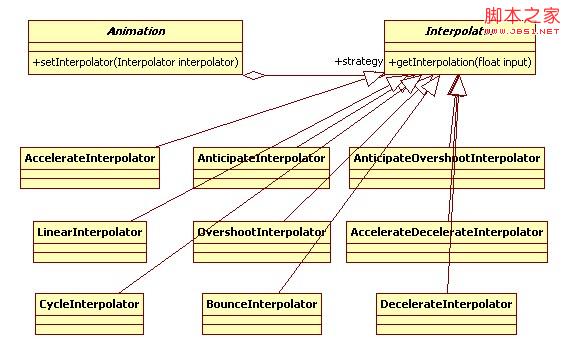
- Android BaseAdapter应用实例
- Android实现多媒体录音笔
- 在当前Activity之上创建悬浮view之WindowManager悬浮窗效果
- 在Android模拟器上模拟GPS功能总是null的解决方法
- android:descendantFocusability方法介绍
- Android巧用ActionBar实现tab导航效果
- Android编程实现擦除Bitmap中某一块的方法
- 基于Android实现随手指移动的ImageView
- Android App中实现图片异步加载的实例分享
- 在android开发中尽量不要使用中文路径的问题详解
- Intent传递对象之Serializable和Parcelable的区别
- 从Cocos2d-x2迁移到Cocos2d-x3的过程分享
- Android获取应用程序大小的方法
- Android使用Theme自定义Activity进入退出动画的方法
- Android实战打飞机游戏之菜单页面设计(1)
- 从源码解析Android中View的容器ViewGroup
- 简介Android应用中sharedPreferences类存储数据的用法
- Android自定义View实现打字机效果
- [Android开发视频教学]01_07_Activity生命周期(一)
- Android实现手势滑动多点触摸缩放平移图片效果(二)
- Android PickerView滚动选择器的使用方法
- Android UI设计系列之自定义SwitchButton开关实现类似IOS中UISwitch的动画效果(2)
- Android中BroadcastReceiver(异步接收广播Intent)的使用
- Android实现ListView分页自动加载数据的方法
- 浅析Android手机卫士之号码归属地查询
- 深入Android MediaPlayer的使用方法详解
- Android开发之TableLayout表格布局
- Android中实现自动生成布局View的初始化代码方法
- Android 去掉状态栏的方法汇总
- android文件上传示例分享(android图片上传)
基于Android设计模式之--SDK源码之策略模式的详解
策略模式其实特别简单(听到这句话,大家是不是心里一下子放松了?)。
比如排序,官方告诉大家我这里有一个排序的接口ISort的sort()方法,然后民间各尽其能,实现这个排序的方法:冒泡,快速,堆等等。
这些方法就是“不同的策略”。
然后,某个模块下,需要一个排序方法,但是暂时不能指定具体的sort方法(出于扩展的考虑),就需要使用ISort接口了。
最后,具体什么场景下,传入什么具体的sort方法,实现灵活的排序。
这就是策略模式!
下面,我们分析Android中的动画是如何使用策略模式的。
1. 意图
定义一系列的算法,把它们一个个封装起来,并且使它们可互相替换。
策略模式使得算法可独立于使用它的客户而变化。
2. 结构图和代码
Animation不同动画的实现,主要是依靠Interpolator的不同实现而变。
定义接口Interpolator:
复制代码 代码如下:
package android.animation;
/**
* A time interpolator defines the rate of change of an animation. This allows animations
* to have non-linear motion, such as acceleration and deceleration.
*/
public interface Interpolator {
/**
* Maps a value representing the elapsed fraction of an animation to a value that represents
* the interpolated fraction. This interpolated value is then multiplied by the change in
* value of an animation to derive the animated value at the current elapsed animation time.
*
* @param input A value between 0 and 1.0 indicating our current point
* in the animation where 0 represents the start and 1.0 represents
* the end
* @return The interpolation value. This value can be more than 1.0 for
* interpolators which overshoot their targets, or less than 0 for
* interpolators that undershoot their targets.
*/
float getInterpolation(float input);
我们以AccelerateInterpolator为例,实现具体的策略,代码如下:
复制代码 代码如下:
package android.view.animation;
import android.content.Context;
import android.content.res.TypedArray;
import android.util.AttributeSet;
/**
* An interpolator where the rate of change starts out slowly and
* and then accelerates.
*
*/
public class AccelerateInterpolator implements Interpolator {
private final float mFactor;
private final double mDoubleFactor;
public AccelerateInterpolator() {
mFactor = 1.0f;
mDoubleFactor = 2.0;
}
/**
* Constructor
*
* @param factor Degree to which the animation should be eased. Seting
* factor to 1.0f produces a y=x^2 parabola. Increasing factor above
* 1.0f exaggerates the ease-in effect (i.e., it starts even
* slower and ends evens faster)
*/
public AccelerateInterpolator(float factor) {
mFactor = factor;
mDoubleFactor = 2 * mFactor;
}
public AccelerateInterpolator(Context context, AttributeSet attrs) {
TypedArray a =
context.obtainStyledAttributes(attrs, com.android.internal.R.styleable.AccelerateInterpolator);
mFactor = a.getFloat(com.android.internal.R.styleable.AccelerateInterpolator_factor, 1.0f);
mDoubleFactor = 2 * mFactor;
a.recycle();
}
public float getInterpolation(float input) {
if (mFactor == 1.0f) {
return input * input;
} else {
return (float)Math.pow(input, mDoubleFactor);
}
}
}
其他的Interpolator实现在此不列举了。
如何在Animation模块实现不同的动画呢?
在这里我想提一个应用很广的概念:依赖注入。
在Animation模块里实现不同的动画,就是需要我们把各个Interpolator以父类或者接口的形式注入进去。
注入的方法一般是构造函数,set方法,注释等等。
我们看看animation类是怎么做的:
复制代码 代码如下:
public abstract class Animation implements Cloneable {
Interpolator mInterpolator;
// 通过set方法注入
public void setInterpolator(Interpolator i) {
mInterpolator = i;
}
public boolean getTransformation(long currentTime, Transformation outTransformation) {
// ... ...
// 具体调用
final float interpolatedTime = mInterpolator.getInterpolation(normalizedTime);
applyTransformation(interpolatedTime, outTransformation);
// ... ...
}
// 缺省实现,是个小技巧,顺便提下,这个不是重点
protected void ensureInterpolator() {
if (mInterpolator == null) {
mInterpolator = new AccelerateDecelerateInterpolator();
}
}
}
策略模式其实就是多态的一个淋漓精致的体现。
3. 效果
(1).行为型模式
(2).消除了一些if...else...的条件语句
(3).客户可以对实现进行选择,但是客户必须要了解这个不同策略的实现(这句话好像是废话,总而言之,客户需要学习成本)
(4).代码注释中提到了缺省实现,可以让客户不了解策略,也能实现默认的策略
(5).注入的方式有多种:构造函数,set方法,注释。配置解析等等
- Android实现树形层级ListView
- Android布局优化之ViewStub控件
- Android实现标题显示隐藏功能
- Android开发中Activity的生命周期及加载模式
- Android实现图片反转、翻转、旋转、放大和缩
- APK程序获取system权限的方法
- 解析Android开发优化之:软引用与弱引用的应